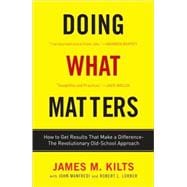When Warren Buffett was asked why the Gillette board of directors chose Jim Kilts to be CEO, he said, “Jim made as much sense in terms of talking about business as anybody I’ve ever talked to. If you listen to Jim analyze a business situation you get absolutely no baloney. And, frankly, finding someone like that is a rarity.”
There is only one CEO in recent times who has faced—and succeeded at—the extraordinary challenges of leading three major companies—Gillette, Nabisco, and Kraft—into prosperous futures by doing what matters on the fundamentals.
That CEO is Jim Kilts. In this vivid first-person account he reveals his system for success that is both cutting-edge and back-to-basics. Doing What Matters—the action plan for identifying and tackling what’s important and ignoring the rest—is the key to winning in a warp-speed world where the need for revolutionary speed and decisiveness increases by the day.
Kilts illustrates his ideas with colorful stories, such as “that little red razor.” A new product idea he proposed early on at Gillette, it was initially shelved because “everyone knew you couldn’t sell a red razor,” but went on to become one of Gillette’s biggest marketing successes ever.
Jim Kilts’s focus on both business fundamentals and personal attributes provides the “complete package,” showing how to get results that make a difference through:
• Intellectual integrity: The ability to face the unvarnished truth about yourself and your business and using what you see as the basis for action.
• Generating emotional engagement and enthusiasm: Using the force of your personality and ideas to infuse people and an entire organization with a sense of purpose and mission.
• Action: Gillette, with just five product lines, had over 20,000 SKUs. After studying the issue for over two years, there were still 20,000. How Kilts got Gillette off the dime to pare down the number to 7,000 almost overnight is an astonishing example of getting the rubber to meet the road—with enormous benefits to the business.
• Understanding the right things through an overarching concept to frame and filter issues: For Jim Kilts it was Total Brand Value, the framework he used in the consumer products industry for achieving better, faster, and more complete results than the competition.
Whether you’re CEO of a multibillion-dollar global company, the brand manager for a product, an entrepreneur starting a small business, or just beginning a career, Doing What Matters provides the practical ideas that get results—ranging from a day one action plan for starting a new job to a chorus of cheers and support to a program of total innovation that involves everyone in changes from small to “big bang.”









